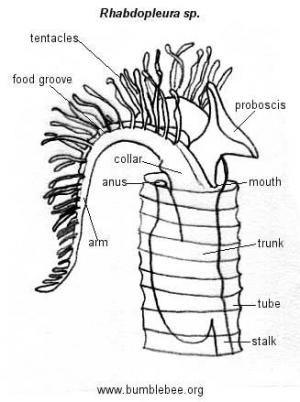Hemichordates
Hemichordata is a phylum of marine deuterostome animals, generally considered the sister group of the echinoderms. They date back to the Lower or Middle Cambrian and include two main classes: Enteropneusta (acorn worms), and Pterobranchia. A third class, Planctosphaeroidea, is known only from the larva of a single species. The extinct class Graptolithina is closely related to the pterobranchs.
Acorn worms are solitary worm-shaped organisms. They generally live in burrows and are deposit feeders, but some species are pharyngeal filter feeders. Pterobranchs are colonial filter-feeding organisms that live in a collagenous tubular structure called a coenecium.
The body plan of hemichordates is characterized by a tripartite organization. The anteroposterior axis is divided into three parts: the anterior prosome, the intermediate mesosome, and the posterior metasome.
The body of acorn worms is worm-shaped and divided into an anterior proboscis, an intermediate collar, and a posterior trunk. The proboscis is a muscular and ciliated organ used in locomotion and in the collection and transport of food particles. The mouth is located between the proboscis and the collar. The trunk is the longest part of the animal. It contains the pharynx, which is perforated with gill slits (or pharyngeal slits), the esophagus, a long intestine, and a terminal anus. It also contains the gonads.
The prosome of pterobranchs is specialized into a muscular and ciliated cephalic shield used in locomotion and in secreting the coenecium. The mesosome extends into one pair (in the genus Rhabdopleura) or several pairs (in the genus Cephalodiscus) of tentaculated arms used in filter feeding. The metasome, or trunk, contains a looped digestive tract, gonads, and extends into a contractile stalk that connects individuals to the other members of the colony, produced by asexual budding. In the genus Cephalodiscus, asexually produced individuals stay attached to the contractile stalk of the parent individual until completing their development. In the genus Rhabdopleura, zooids are permanently connected to the rest of the colony via a common stolon system.
They have a diverticulum of the foregut called a stomochord, previously thought to be related with the chordate notochord, but this is most likely the result of convergent evolution rather than homology. A hollow neural tube exists among some species (at least in early life), probably a primitive trait they share with the common ancestor of chordata and the rest of the deuterostomes.
Source: http://en.wikipedia.org/wiki/Hemichordata | ||
Virtual museum of the Czech Geological Survey, www.geology.cz, (C) Czech Geological Survey, 2011, v.0.99 [13.12.2011]


![[ENG]](img/vlajka-cr.gif) Česky
Česky 
